
When I first read the government’s new phonics-inspired writing framework, I felt a mix of hope and hesitation.
On the one hand, it’s great to see handwriting finally getting the recognition it deserves. But as someone who works with children every day, many of whom struggle with writing, I couldn’t help but feel something important was missing:
Where’s the space for creativity?
Let me walk you through what I think the framework gets right, what concerns me, and how I believe we can build a bridge between structured writing and imaginative thinking.
What I Like About It
There are some genuinely positive steps in this new approach:
- Speaking before writing – Children are encouraged to say their sentences aloud first. This is brilliant because it gives them the chance to organise their thoughts before putting pencil to paper.
- A focus on handwriting from the start – No more leaving handwriting as an afterthought. That’s something I’ve been saying for years!
- Cross-curricular writing – Encouraging writing in subjects beyond English demonstrates its essential role in every aspect of learning.
You can read the full announcement from the Department for Education here on GOV.UK.
So far, so good.
But… Here’s Where I’m Worried
Even though the intentions are great, I do have some concerns:
1. It feels a bit too… rigid.
Yes, phonics is important. But when writing becomes all about ticking boxes and blending sounds, we risk taking the joy out of it.
2. There’s not enough room for imagination.
The framework focuses so much on structure that it forgets the magic. Where are the dragons, talking trees, silly squirrels, and secret treasure maps?
3. Handwriting needs a purpose.
If children are just practising letters with no context, it can feel boring. But when they write to create, everything changes. That’s where confidence and love of learning grow.
What I Think Could Work Better
Rather than discarding the framework, we can build upon it. Here’s what I’ve been doing in my sessions and what I’d love to see more of in classrooms, too:
1. Make oral composition fun
If the framework says, “Say your sentence first,” then I say: “Make it silly first!”
We might come up with something like:
“The squirrel slipped on a shiny shoe while singing a song!”
And then write it out together.
2. Turn handwriting into storytelling
I often bring in Scribble the Squirrel to help children write postcards, comic strips, or silly diary entries.
It’s still writing, it still uses phonics, but now there’s a story behind it.
3. Link handwriting to thinking
Handwriting is so much more than neatness. It builds memory, focus, and creativity. When kids write something they’ve imagined themselves, they’re not just practising, they’re learning to express who they are.
My Final Thoughts
The new framework has its heart in the right place. Teaching writing with more structure, earlier on, is something we need.
But we mustn’t forget the joy.
When handwriting becomes a gateway to self-expression rather than just something to “get right,” that’s when confidence grows. That’s when kids start saying, “Can I write another one?”
So yes, let’s follow the framework. But let’s also add colour, character, and creativity. That’s the balance I’ll always advocate for.
Want to Make Handwriting More Fun at Home?
If you’d love some ideas to bring handwriting to life for your child, that’s exactly what I do!
At Learn with Aleks and Scribble the Squirrel, I help children become confident, capable writers—one imaginative step at a time.
Pop me a message or head to www.learnwithaleks.com to find out more.

0 Comments